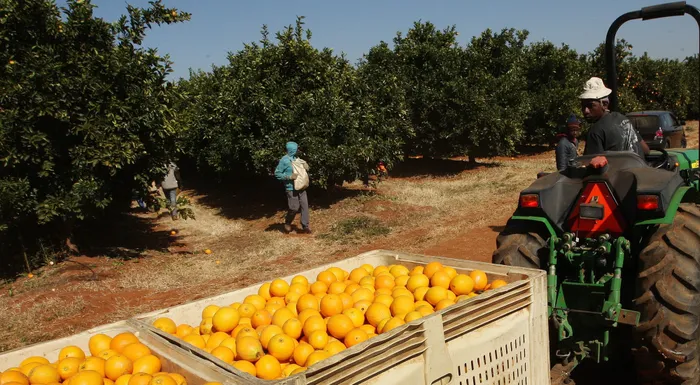Agriculture industry in the country exposed to Russia/Ukraine fallout, says Agbiz

Agricultural markets would be affected by the disruption caused after Russia invaded Ukraine, and South Africa’s agribusinesses and farmers would not be insulated, primarily through the price transmission of a range of commodities and inputs, the Agricultural Business Chamber (Agbiz) said yesterday. Photo: Simphiwe Mbokazi
AGRICULTURAL markets would be affected by the disruption caused after Russia invaded Ukraine, and South Africa’s agribusinesses and farmers would not be insulated, primarily through the price transmission of a range of commodities and inputs, the Agricultural Business Chamber (Agbiz) said yesterday.
The citrus industry and the supply of fertiliser would be impacted.
However, a lot remained unknown about the coming weeks and months, according to chief economist Wandile Sihlobo.
He said yesterday there were risks for countries that exported to Russia and in South Africa’s case, as the fruit industry exported substantial volumes to Russia.
His comments come in the wake of the US, UK and Europe imposing a new round of sanctions against Russia for its invasion of Ukraine, which excluded some Russian banks from the SWIFT system – a messaging system network that connects banks around the world and is considered the backbone of international finance.
For example in 2020, Russia accounted for 7 percent of South Africa’s citrus exports in value terms and accounted for 12 percent of South Africa’s apples and pears exports in the same year – the country’s second-largest market.
Sihlobo said Russia was also integrated into global agriculture from an input supply perspective, particularly in fertiliser supplies.
According to data from Trade Map, Russia was the world’s leading exporter of fertiliser materials in value terms followed by China, Canada, the US, Morocco, and Belarus.
These fertiliser mixtures included minerals or chemicals, nitrogenous fertilisers, phosphoric fertilisers, and potassic fertilisers.
“As with the grains and oilseeds market, the actual disruption of export activity is yet to unfold fully. But the sanctions, including the agreement to exclude some Russian banks from global payments systems such as SWIFT, could negatively affect its trading activity. This disruption could add upside pressure to the already higher global fertiliser prices,” Sihlobo said.
Fertiliser prices increased sharply throughout 2021 and remained elevated at the beginning of this year. For instance in January, 2022 international ammonia, urea, di-ammonium phosphate, and potassium chloride prices were up by 220 percent, 148 percent, 90 percent, and 198 percent from January, 2021 respectively.
There were many factors behind these sharp input cost increases, such as the supply constraints in critical fertiliser-producing countries mainly China, India, the US, Russia and Canada. Rising shipping costs and oil and gas prices were also contributing factors to the price increases, along with firmer global demand from the growing global agriculture.
Agbiz said that the Russia/Ukraine conflict would add upside pressure to these already higher fertiliser prices, particularly if Russia’s exports suffer as a result of sanctions.
Primary markets for Russia’s fertiliser material were Brazil, Estonia, China, India, the US, Finland, Mexico, Poland, Romania and Latvia, among others.
According to Agbiz, even countries that have minimal direct fertiliser imports from Russia, such as South Africa, which was the 36th largest fertiliser materials market for Russia, would experience the price pressures from the international market.
US Secretary of Agriculture Tom Vilsack recently expressed similar concerns about the potential price increases, even in the event that the US might be able to produce and meet its domestic fertiliser needs in the near to medium term.
Sihlobo said unlike the US, South Africa’s domestic fertiliser production capacity was weak, in part because of the lack of some input minerals.
South Africa imports about 80 percent of its annual fertiliser consumption and is a minor player globally, accounting for 0.5 percent of total global consumption. Therefore, local prices tend to be influenced by developments in the major producing and consuming countries, such as Russia and the other major fertiliser players mentioned.
From the domestic usage perspective, much of the fertiliser imported by South Africa was used in maize production, accounting for about 41 percent of total fertiliser consumption.
The second-largest consumer was sugar cane farming at 18 percent. Fertiliser constitutes about 35 percent of grain farmers’ input costs and a substantial share in other agricultural commodities and crops. The summer crop farming areas were already planted, with these higher input costs. They would not be procuring fertilisers until around mid-year and into the third quarter of the year when they prepare for the next season (ie the 2022/23 production season).
Depending on the Russia/Ukraine conflict’s timeframe and the extent of the response measures such as sanctions by other countries, Sihlobo said fertiliser prices could still be elevated when the next planting season started.
“In the near term, we are most worried about the winter crop-producing areas such as wheat, barley, canola and oats, among others, that have to start the new planting season at the end of April. The farmers and agribusinesses that have not secured their supplies could be exposed to upside price shocks. The horticulture farmers and agribusinesses could also be affected to an extent by the higher input costs in the near term,” Sihlobo said.
Related Video:
given.majola@inl.co.za
BUSINESS REPORT ONLINE
Related Topics: